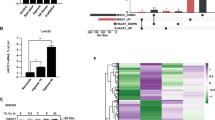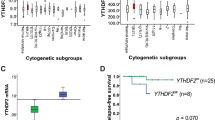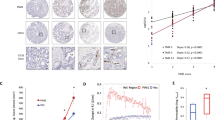Abstract
The mechanisms of malignant cell transformation mediated by the oncogenic anaplastic lymphoma kinase (ALK) tyrosine kinase remain only partially understood. In this study, we report that T-cell lymphoma (TCL) cells carrying the nucleophosmin (NPM)/ALK fusion protein (ALK+ TCL) strongly express hypoxia-induced factor 1α (HIF1α) mRNA, even under normoxic conditions, and markedly upregulate HIF1α protein expression under hypoxia. HIF1α expression is strictly dependent on the expression and enzymatic activity of NPM/ALK, as shown in BaF3 cells transfected with wild-type NPM/ALK and kinase-inactive NPM/ALK K210R mutant and by the inhibition of the NPM/ALK function in ALK+ TCL cells by a small-molecule ALK inhibitor. NPM/ALK induces HIF1α expression by upregulating its gene transcription through its key signal transmitter signal transducer and activator of transcription 3 (STAT3), which binds to the HIF1α gene promoter as shown by the chromatin immunoprecipitation assay and is required for HIF1α gene expression as demonstrated by its small interfering RNA-mediated depletion. In turn, depletion of HIF1α increases mammalian target of rapamycin complex 1 activation, cell growth and proliferation and decreases vascular endothelial growth factor synthesis. These results identify a novel cell-transforming property of NPM/ALK, namely its ability to induce the expression of HIF1α, a protein with an important role in carcinogenesis. These results also provide another rationale to therapeutically target NPM/ALK and STAT3 in ALK+ TCL.
This is a preview of subscription content, access via your institution
Access options
Subscribe to this journal
Receive 50 print issues and online access
$259.00 per year
only $5.18 per issue
Buy this article
- Purchase on Springer Link
- Instant access to full article PDF
Prices may be subject to local taxes which are calculated during checkout




Similar content being viewed by others
References
Bertout JA, Patel SA, Simon MC . (2008). The impact of O2 availability on human cancer. Nat Rev Cancer 8: 967–975.
Bischof D, Pulford K, Mason DY, Morris SW . (1997). Role of the nucleophosmin (NPM) portion of the non-Hodgkin's lymphoma-associated NPM-anaplastic lymphoma kinase fusion protein in oncogenesis. Mol Cell Biol 17: 2312–2325.
Brugarolas J, Lei K, Hurley RL, Manning BD, Reiling JH, Hafen E et al. (2004). Regulation of mTOR function in response to hypoxia by REDD1 and the TSC1/TSC2 tumor suppressor complex. Genes Dev 18: 2893–2904.
Chiarle R, Gong JZ, Guasparri I, Pesci A, Cai J, Liu J et al. (2003). NPM-ALK transgenic mice spontaneously develop T-cell lymphomas and plasma cell tumors. Blood 101: 1919–1927.
Chiarle R, Voena C, Ambrogio C, Piva R, Inghirami G . (2008). The anaplastic lymphoma kinase in the pathogenesis of cancer. Nat Rev Cancer 8: 11–23.
Fujimoto J, Shiota M, Iwahara T, Seki N, Satoh H, Mori S et al. (1996). Characterization of the transforming activity of p80, a hyperphosphorylated protein in a Ki-1 lymphoma cell line with chromosomal translocation t (2; 5). Proc Natl Acad Sci USA 93: 4181–4186.
Evens AM, Schumacker PT, Helenowski IB, Singh AT, Dokic D, Keswani A et al. (2008). Hypoxia inducible factor-alpha activation in lymphoma and relationship to the thioredoxin family. Br J Haematol 141: 676–680.
Galkin AV, Melnick JS, Kim S, Hood TL, Li N, Li L et al. (2007). Identification of NVP-TAE684, a potent, selective, and efficacious inhibitor of NPM-ALK. Proc Natl Acad Sci USA 104: 270–275.
Giatromanolaki A, Koukourakis MI, Pezzella F, Sivridis E, Turley H, Harris AL et al. (2008). Phosphorylated VEGFR2/KDR receptors are widely expressed in B-cell non-Hodgkin's lymphomas and correlate with hypoxia inducible factor activation. Hematol Oncol 26: 219–224.
Kasprzycka M, Marzec M, Liu X, Zhang Q, Wasik MA . (2006). Nucleophosmin/ anaplastic lymphoma kinase (NPM/ALK) oncoprotein induces the T regulatory cell phenotype by activating STAT3. Proc Natl Acad Sci USA 103: 9964–9969.
Kuefer MU, Look AT, Pulford K, Behm FG, Pattengale PK, Mason DY et al. (1997). Retrovirus-mediated gene transfer of NPM-ALK causes lymphoid malignancy in mice. Blood 90: 2901–2910.
Li R, Morris SW . (2008). Development of anaplastic lymphoma kinase (ALK) small-molecule inhibitors for cancer therapy. Med Res Rev 28: 372–412.
Ling X, Arlinghaus RB . (2005). Knockdown of STAT3 expression by RNA interference inhibits the induction of breast tumors in immunocompetent mice. Cancer Res 65: 2532–2536.
Lu L, Ghose AK, Quail MR, Albom MS, Durkin JT, Holskin BP et al. (2009). ALK mutants in the kinase domain exhibit altered kinase activity and differential sensitivity to small molecule ALK inhibitors. Biochemistry 48: 3600–3609.
Marzec M, Kasprzycka M, Liu X, El-Salem M, Halasa K, Raghunath PN et al. (2007). Oncogenic tyrosine kinase NPM/ALK induces activation of the rapamycin-sensitive mTOR signaling pathway. Oncogene 26: 5606–5614.
Marzec M, Kasprzycka M, Ptasznik A, Wlodarski P, Zhang Q, Odum N et al. (2005). Inhibition of ALK enzymatic activity in T-cell lymphoma cells induces apoptosis and suppresses proliferation and STAT3 phosphorylation independently of Jak3. Lab Invest 85: 1544–1554.
Marzec M, Zhang Q, Goradia A, Raghunath PN, Liu X, Paessler M et al. (2008). Oncogenic kinase NPM/ALK induces through STAT3 expression of immunosuppressive protein CD274 (PD-LI, B7-H1). Pro Natl Acad Sci USA 105: 20852–20857.
Morris SW, Kirstein MN, Valentine MB, Dittmer KG, Shapiro DN, Saltman DL et al. (1994). Fusion of a kinase gene, ALK, to a nucleolar protein gene, NPM, in non-Hodgkin's lymphoma. Science 263: 1281–1284.
Morris SW, Naeve C, Mathew P, James PL, Kirstein MN, Cui X et al. (1997). ALK, the chromosome 2 gene locus altered by the t (2; 5) in non-Hodgkin's lymphoma, encodes a novel neural receptor tyrosine kinase that is highly related to leukocyte tyrosine kinase (LTK). Oncogene 14: 2175–2188.
Niu G, Briggs J, Deng J, Ma Y, Lee H, Kortylewski M et al. (2008). Signal transducer and activator of transcription 3 is required for hypoxia-inducible factor-1alpha RNA expression in both tumor cells and tumor-associated myeloid cells. Mol Cancer Res 6: 1099–1105.
Passam FH, Alexandrakis MG, Kafousi M, Fotinou M, Darivianaki K, Tsirakis G et al. (2009). Histological expression of angiogenic factors: VEGF, PDGFRalpha, and HIF-1alpha in Hodgkin lymphoma. Pathol Res Pract 205: 11–20.
Semenza GL . (2003). Targeting HIF-1 for cancer therapy. Nat Rev Cancer 3: 721–732.
Shiota M, Fujimoto J, Semba T, Satoh H, Yamamoto T, Mori S . (1994). Hyperphosphorylation of a novel 80 kDa protein-tyrosine kinase similar to Ltk in a human Ki-1 lymphoma cell line, S3. Oncogene 9: 1567–1574.
Wasik MA, Zhang Q, Marzec M, Kasprzycka M, Wang HY, Liu X . (2009). Anaplastic lymphoma kinase (ALK)-induced malignancies: novel mechanisms of cell transformation and potential therapeutic approaches. Semin Oncol 36: 27–35.
Wright CW, Duckett CS . (2009). The aryl hydrocarbon nuclear translocator alters CD30-mediated NF-kappaB-dependent transcription. Science 323: 251–255.
Yu H, Jove R . (2004). The STATs of cancer-new molecular targets come of age. Nat Rev Cancer 4: 97–105.
Yue P, Turkson J . (2009). Targeting STAT3 in cancer: how successful are we? Expert Opin Investig Drugs 18: 45–56.
Zhang Q, Raghunath PN, Xue L, Majewski M, Carpentieri DF, Odum N et al. (2002). Multilevel dysregulation of STAT3 activation in anaplastic lymphoma kinase-positive T/null-cell lymphoma. J Immunol 168: 466–474.
Zhang Q, Wang HY, Liu X, Wasik MA . (2007). STAT5A is epigenetically silenced by the tyrosine kinase NPM1-ALK and acts as a tumor suppressor by reciprocally inhibiting NPM1-ALK expression. Nat Med 13: 1341–1348.
Acknowledgements
This study was supported in part by grants from the National Cancer Institute- R01-CA89194 and R01-CA96856.
Author information
Authors and Affiliations
Corresponding author
Ethics declarations
Competing interests
The authors declare no conflict of interest.
Rights and permissions
About this article
Cite this article
Marzec, M., Liu, X., Wong, W. et al. Oncogenic kinase NPM/ALK induces expression of HIF1α mRNA. Oncogene 30, 1372–1378 (2011). https://doi.org/10.1038/onc.2010.505
Received:
Revised:
Accepted:
Published:
Issue Date:
DOI: https://doi.org/10.1038/onc.2010.505
Keywords
This article is cited by
-
Chimeric kinase ALK induces expression of NAMPT and selectively depends on this metabolic enzyme to sustain its own oncogenic function
Leukemia (2023)
-
A causal link from ALK to hexokinase II overexpression and hyperactive glycolysis in EML4-ALK-positive lung cancer
Oncogene (2016)
-
Mechanistic insight into ALK receptor tyrosine kinase in human cancer biology
Nature Reviews Cancer (2013)
-
Identification of HIF-1α promoter and expression regulation of HIF-1α gene by LPS and hypoxia in zebrafish
Fish Physiology and Biochemistry (2013)
-
Selective Therapeutic Targeting of the Anaplastic Lymphoma Kinase With Liposomal siRNA Induces Apoptosis and Inhibits Angiogenesis in Neuroblastoma
Molecular Therapy (2011)



